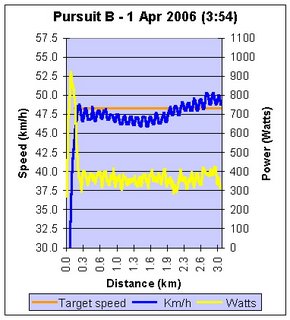(or how to go faster without really trying)
Reproduced from an article I wrote in May 2006 for Velosportz.com.au
The Individual Pursuit is one of cycling’s gold riband events that almost every cyclist should try at least once in their careers. It is one of the most challenging cycling events there is and taxes a cyclist’s abilities to the maximum. It is also a really solid indicator of a rider’s physical abilities across many cycling disciplines. So how on earth do you ride one well? Well there are a lot of things about being and/or becoming a good pursuit rider and I’m not going to attempt to cover them all here (I certainly don’t profess to be an expert). What I will share is some first hand information about pacing and its importance, since it is the most important skill in pursuiting.
Individual Pursuit (Men/women) – Courtesy of Cyclingnews.com
Held over 4000 metres for elite men and 3000 metres for elite women (shorter for masters riders), this is considered an "endurance" track event, although the speeds are still extremely high. Two riders start on opposite sides of the track and try to set the fastest time over the allotted distance. Normally, a qualifying time trial is ridden that determines who is eligible for the finals. The fastest ride is often produced here, as in the finals, the only important criterion is to beat your opponent. If one rider catches the other, i.e. puts half a lap into them, then the race is over.
An explosive start is not critical (but it's handy to have), however the ability to ride at a consistently high speed is far more important. Many riders who go out too hard can look to be well up on their opponent, only to fade in the last 1000 metres. This has typically the greatest "cross-over" to the road. i.e. good pursuiters make good road riders and vice versa. Brad McGee, Stuart O'Grady, Vjatcheslav Ekimov, and Chris Boardman are a few examples of top pursuiters who have had successful road careers.
Every rider has a limit to his or her anaerobic and aerobic work capacities (and we can all work to improve them). However, come race day, the trick is working out how to best use your current capacities to ride the distance in the shortest time possible. Pacing is the key to success.
Let me demonstrate what I mean.
Below are three power and speed charts for Individual Pursuit efforts I have done over the last two months [1]. Apart from the public embarrassment, these charts highlight some really important lessons about pursuit pacing.
Each chart shows three lines:
- The Blue line is speed - shown against the left axis in km/h
- The Orange line is target cruise speed (in this case 48.3km/h)
- The Yellow line is power in watts as shown against the right hand side axis.
Ride B shows a somewhat different pacing strategy.
 In this case I started too conservatively, realizing half way that a lift in effort was both needed and possible, resulting in negative splits all the way to the finish (but too late to make use of all the petrol in the tank).
In this case I started too conservatively, realizing half way that a lift in effort was both needed and possible, resulting in negative splits all the way to the finish (but too late to make use of all the petrol in the tank).Ride C represents the classic pursuit pacing mistake - starting out hard (note peak power this time is well over 1000 watts and initial cruising power/pace is higher than the target) resulting in me being unable to maintain the effort, with the final laps an ugly experience, something I'm sure plenty of others who have ridden the event can relate to.
Now let’s compare the average power outputs with times:
Ride__ Avg Watts__ Time (3km)
__A__ 384 Watts__ 3:49
__B__ 388 Watts__ 3:54
__C__ 377 Watts__ 3:55
It is amazing to see that Ride A has a time 5 seconds faster than ride B but with slightly less average power!
Ride C is typical of many novice pursuiters (myself included). In my case I instructed my caller to use this pacing strategy as I wanted to find out what I really had in me on that day, knowing it was risky and the fact that even a personal best (PB) time was not going to qualify me for finals.
Ride B was my biggest disappointment as I clearly had the legs on the day to do a PB but simply didn't put it all on the line.
Ride A proves that with some practice, especially that crucial first lap and a half, perfect pacing is possible and a PB performance is just around the corner. Just try to hold back in the initial stages (but not too much!).
So how valuable is pacing strategy? Pretty important I would say. Anyone else out there want to knock 5 seconds off his or her pursuit time for no more actual effort?
It is easy to know the theory of perfect pursuit pacing but applying it is another thing altogether, so get to your local track and give it a blast. It’s the most fun on two wheels.
Happy pursuiting!
Alex





0 comments:
Post a Comment